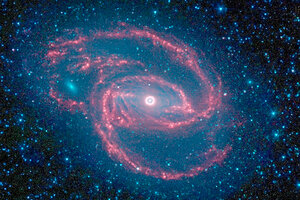Black holes can devour entire galaxies, scientists say
Supermassive black holes are thought to reside at the center of almost every galaxy. Sometimes they end up destroying their home.

This July 23, 2009 image taken by NASA's Spitzer Space Telescope shows the NGC-1097 galaxy, located some 50 million light-years away. NGC-1097 is spiral-shaped like our Milky Way, with long, spindly arms of stars. The 'eye' at the center of the galaxy is actually a monstrous black hole surrounded by a ring of stars.
AP/NASA
Black holes might kill entire galaxies with blazing energy, dooming embryonic stars before they can get born and condemning the remaining stars to a slow death, scientists have found.
Although nothing can escape from a black hole, before matter falls into one, it swirls around to form a disk that heats up as it packs together, radiating energy.
Supermassive black holes are thought to reside at the center of almost every galaxy, with some growing to billions of times the mass of our sun. To see what impact these monsters might have, researchers relied on data from the Hubble Space Telescope and the Chandra X-ray Observatory, looking for galaxies with very high X-ray emissions, a classic signature of black holes devouring gas and dust.
The scientists discovered the accretion disks of super-massive black holes in at least one-third of all the massive galaxies in the universe far outshines the combined output of the hundreds of billions of stars in their host galaxies at some point in their histories. This outpouring of energy is high enough to strip apart every massive galaxy in the cosmos 25 times over, while the X-ray emission from them turns out to dwarf that from every other source in the universe put together.
All this radiation can drive away the gas and dust that serve as the raw ingredients of new stars, permanently shutting down star formation in the surrounding galaxy. The remaining stars age, redden, die and are never replaced.
"We are left with a startling picture of the formation history of massive galaxies, where dramatic violence in the form of the torrent of radiation from matter falling into black holes leads to the death of galaxies they inhabit," said researcher Asa Bluck, an astrophysicist at the University of Nottingham in England.
"Black holes form inside their host galaxies and grow in proportion to them, forming an accretion disc which will eventually destroy the host," he added. "In this sense they can be described as viral in nature."
Still, "massive galaxies are in the minority in our visible universe," Bluck noted. "About one in a 1,000 galaxies is thought to be massive, but it may be much less."
Many other galaxies "would be too small to harbor really massive super-massive black holes, so would be unlikely to have really dramatic outpourings of radiation leading to the death of galaxies like we see in many very massive galaxies," Bluck told SPACE.com. "However, there is still likely to be some effect from this even in small systems."
When it comes to our own galaxy, "this is actually quite a big galaxy, but has an abnormally diminutive central black hole," Bluck noted. "Currently it is in a quiescent stage — not outputting much energy — but this could change in the future."
For instance, "we expect our own galaxy and Andromeda to merge in about 4 billion years or so," Bluck explained. "If this ends up providing new gas reserves and channeling this gas to the center of our galaxy — all big ifs — then there is a real chance of triggering our dormant black hole at some point in the distant future."
"But don't worry," he added, "our sun will have sputtered out by then anyway."
Asa and his colleagues detailed their findings at the Royal Astronomical Society National Astronomy Meeting in Glasgow on April 16. They will submit their research to the Monthly Notices of the Royal Astronomical Society.
Amazing Galaxy Photos by Stargazers
